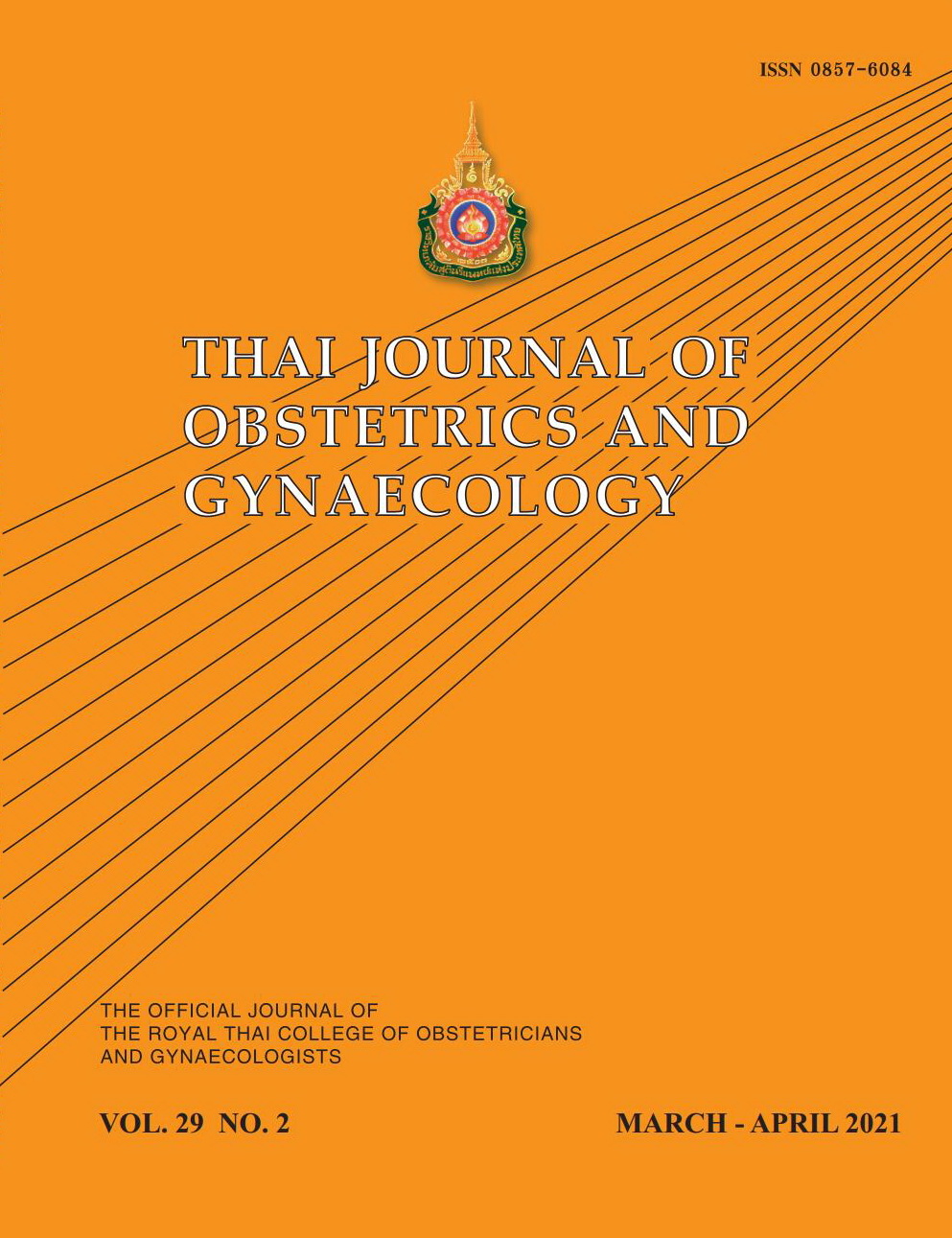A Comparison of Cervical Ruler and Transvaginal Ultrasound for Cervical Length Measurement during Pregnancy
Main Article Content
Abstract
Objective: To identify and compare the correlation between cervical length measured by transvaginal ultrasound and cervical ruler.
Materials and Methods: A cross-sectional study was conducted in 200 singleton pregnant women who received antenatal care at Chonburi Hospital during September 1, 2018 to June 30, 2019. Transvaginal ultrasound and Cervical ruler for cervical measurement were performed during 16 to 24 weeks of gestation. Maternal age, parity, pre-pregnancy weight, pre-pregnancy body mass index, history of abortion, history of preterm birth, smoking behavior, alcohol drinking and drug used during pregnancy were collected. Pearson’s Correlation Coefficient and paired T-test were used to evaluate the correlation and difference between cervical lengths measured by transvaginal ultrasound and cervical ruler.
Results: A total of 200 singleton pregnant women participated in the study. The average cervical length measured by transvaginal ultrasound and cervical ruler were 3.92 ± 0.71 cm. and 3.4 ± 0.73 cm., respectively. The mean difference of both methods was 0.52 cm. (95% confidence interval 0.46 to 0.57, P-value < 0.001). The correlation coefficient of cervical length measured by transvaginal ultrasound and cervical ruler was 0.843.
Conclusion: The cervical length measured by cervical ruler was correlated with the cervical length measured by transvaginal ultrasound; however, the average cervical length measured by cervical ruler was statistically significantly lower than those measured by transvaginal ultrasound.
Article Details
References
2. Chawanpaiboon S, Kanokpongsakdi S. Preterm birth at Siriraj hospital: a 9-year period review (2002-2010). Siriraj Med J 2017;63:143-6.
3. Chawanpaiboon S,Sutantawibul A, Pimol K, Srisomboon R, Worapitaksanond S. Preliminary study: comparison of the efficacy of progesterone and nifedipine in inhibiting threatened preterm labour in Siriraj Hospital. Thai J of Obstet Gynaecol 2009;17:23-9.
4. Berghella V. Novel developments on cervical length screening and progesterone for preventing preterm birth. BJOG 2009;116:182-7.
5. American College of Obstetricians and Gynecologists. ACOG practice bulletin No.142: cerclage for the management of cervical insufficiency. ObstetGynecol 2014;123:372-9.
6. American College of Obstetricians and Gynecologists.ACOG Practice bulletin No. 130:Prediction and prevention of preterm birth.. Obstet Gynecol 2012;120:964-73.
7. Ross MG, Beall MH. Prediction of preterm birth: nonsonographic cervical methods. Semin Perinatol 2009;33:312-6.
8. Lavin JP Jr, Guy M, Gil K, Crane S. The use of the Cervilenz device to aid in the diagnosis of premature labor. J Matern Fetal Neonatal Med 2013;26:1816-9.
9. Baxter JK, Adair CD, Paidas MJ, Hoffman MK, Kivel FJ, Cebrik D, et al. Assessment of a cervicometer compared to transvaginal ultrasound in identifying women with a short cervical length: a multicenter study. Am J Obstet Gynecol 2016;215:229e1-7.
10. Möller MI, HandersonJJ, Nathan EA,Pennell CE. Cervilenz™ is an effective tool for screening cervical-length in comparison to transvaginal ultrasound.J Matern-Fetal Neonatal Med 2013;26:378-82.
11. Kagan KO,Sonek J. How to measure cervical length.Ultrasound Obstet Gynecol 2015;45:358-62.
12. Burwick RM, Zork NM, Lee GT, Ross MG, Kjos SL. Cervilenz assessment of cervical length compared to fetal fibronectin in the prediction of preterm delivery in women with threatened preterm labor. J Matern Fetal Neonatal Med 2011;24:127-31.


